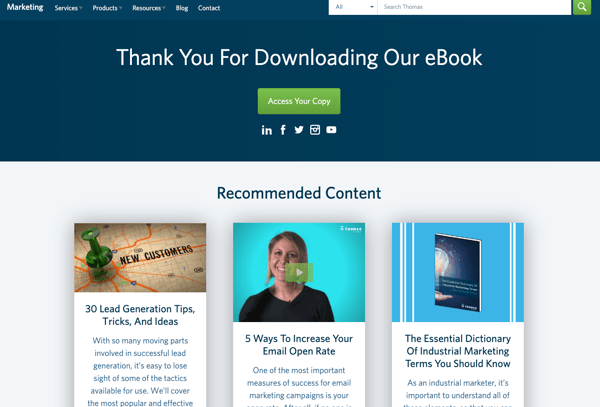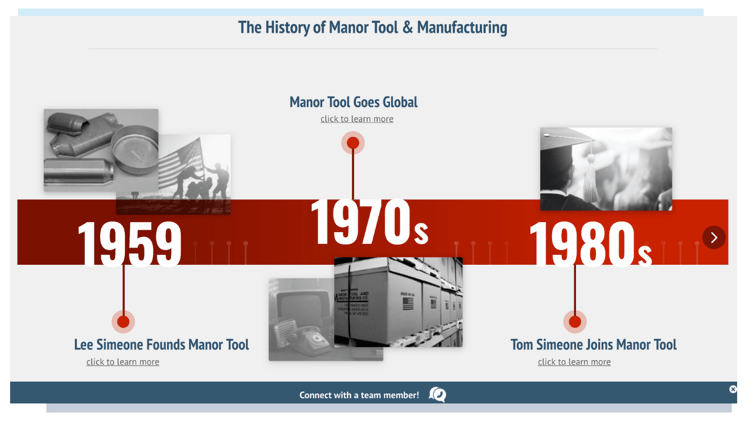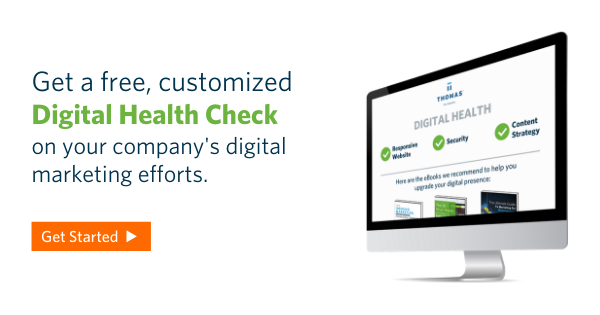Types Of Email Marketing: 10 Emails You Should Be Sending
Team Thomas July 12, 2022
Whether you are just starting with email marketing or you're already sending marketing emails every week, you know that emails are one of the best channels to sell — and smart marketers are always looking for new ways they can build relationships and grow revenue.
You might be asking yourself: Should I nurture subscribers with weekly newsletters? Are dedicated sends (standalone emails with one offer) better at optimizing my sales and marketing funnel? What about email digests?
These are all valid questions manufacturing marketers find themselves asking when selecting the right format to meets their email marketing goals.
In this post, we review the different types of marketing emails you can send, and their respective advantages and disadvantages — this information should help you make an educated decision about picking the most appropriate email type and how to go about using it.
Most Common Email Marketing Types
1. Welcome Emails
Initial contact with prospects typically finds them unready to do business.
In fact, research shows that only 25% of leads are immediately sales-ready while 50% of leads are qualified but not yet ready to buy.
Nurturing, therefore, is critical for pushing your leads closer to the buying stage.
Welcome emails show better open and click-through rates when they offer a personal touch and introduce your organization without slathering on the sales pitch. Don’t introduce a new product or service before you’ve built a relationship. Simply work on giving off a good first impression — one that illustrates your industry knowledge and expertise — and pave the way for future contact.
Advantages Of Welcome Emails
- The Start Of A Business Partnership: When you fire off that first welcome email to potential prospects, it's the first step in forming a relationship. When done correctly, this will be a positive experience for them and will leave them more receptive to future emails. In fact, subscribers who read an initial welcome email will read 40 percent more content from a sender over the subsequent 180 days.
- Boost Metrics: Welcome emails have higher open rates and click-through rates than standard marketing emails. This can be a good way to kickstart your email marketing metrics for the better.
Disadvantages Of Welcome Emails
- Bad First Impressions: A welcome email is the first communication you will have with a potential buyer, and if you don't nail it right out of the gate, you can blow a chance of closing a deal.
2. Email Newsletters
Many businesses and organizations send email newsletters to stay top of mind for their recipients.
Most industrial businesses actually use email newsletters as the foundation of their email marketing program because they are great tools for educating customers and prospects about your business and showcasing employee profiles, company passion projects, and relevant graphics.
Before we get into the nitty-gritty details of creating email newsletters, you will need to determine your goal.
What is it that you want your email newsletter to achieve? You might want to nurture your existing contacts and become the first brand they think of when they need a product or service in your industry. Or your goal might be to increase sharing so that you attract new people to your list.
As you define your goal, think about what metrics you can use to track your progress.
Read More: Marketing Goals Vs. Marketing Strategy
Newsletters are great not only for marketing to prospects but also for nurturing your existing customers with company news and events, product announcements and feedback requests. Such ongoing communication will help you retain happy customers and collect valuable insights about them, so make sure you're using a marketing CRM such as HubSpot to send your emails and track metrics.
For example, if your goal is to drive traffic to specific pages, you would need to closely monitor click-through rates (CTR). A CTR measures the number of times someone has clicked the link versus the number of people who viewed the link.
What kinds of links do they click on the most? Can you upsell to them at all? Which email subject lines have a high open rate? What time of the day is better to send an email? Without a marketing CRM, these questions are left unanswered — and actually one of the top pitfalls industrial sellers and marketers experience.
(Need a refresher on marketing terms? Check out The Essential Dictionary Of Industrial Marketing Terms You Should Know.)
As you work on your newsletter layout and content creation, stay mindful of your goal and make sure you are working towards meeting it by prioritizing the design and placement of calls-to-actions.
Advantages Of Email Newsletters
- Brand Awareness: Similar to newspapers, newsletters create certain anticipation in readers. Whether it is a daily newsletter or a weekend communication, readers get into the habit of receiving it. So if you're considering sending email newsletters, make sure you're sending them on a regular cadence. If readers enjoy the content, they will most likely stay subscribed to the newsletter. Building a habit in your email subscribers enables them to recognize your brand and associate it with a positive sentiment.
- Repurpose Content: Newsletters generally contain information that you have already published. Many companies do quick summaries of their most popular blog posts and link to the articles from their newsletter. In this way, they bring subscribers back to the company website and engage them with more company content.
- Diverse Content: Email newsletters give you the freedom to include different content types all in one email that might be important to your organization. For instance, the same newsletter can contain a popular blog post, a new offer, an announcement of an upcoming event, information about a discount and a link to a survey. There might even be a video embedded in the email. (We'll touch on videos in a bit!)
Disadvantages Of Email Newsletters
- Diluted Call-To-Action: Due to their format — a long compilation of information — newsletters can be overwhelming with multiple calls-to-action. If you include a series of blurbs or article summaries, the attention of your recipients will most likely be spread across these tidbits of information as opposed to staying focused on a certain element. Of course, you can address this by prioritizing the most important information at the top of the newsletter and include a clear call-to-action after/alongside each block of text.
- Design: With newsletters, the layout becomes a much more complicated task than with dedicated email sends. You’ll have to spend some time deciding on the right placement of images and text, alignment and prioritization of information. (This is where A/B testing comes into play.)

3. Dedicated Emails
Dedicated emails — also known as standalone emails — contain information about only one offer. For instance, you can notify your target audience about a new white paper you have released or invite them to attend an industry event that you are hosting.
Dedicated emails help you set up the context to introduce the main call-to-action. In this sense, they are similar to landing pages. Dedicated sends are generally used to reach out to your entire email database — a practice that is not necessarily efficient in optimizing conversions and minimizing unsubscribes.
While there are instances when all of your subscribers should be notified, such as a timely new offer or an unprecedented national emergency, in most cases you would want to segment heavily based on your subscribers’ different behaviors and interests.
Advantages Of Dedicated Emails
- Focused Call-To-Action: Unlike newsletters, dedicated sends can focus on really driving results for one call-to-action, because there is just one message and one goal.
- Easy To Build: Once you have your email template in place, building dedicated sends should be easy. You will generally grab some of the information already on the landing page, make a few tweaks to it and spend most time nailing down the subject line.
- Fast To Measure: Naturally, if you have one main message and call-to-action in your dedicated send, it will be easy for you to track progress. You can quickly check the email CTR, landing page views and conversions, and follow the long-term ROI.
Disadvantages Of Dedicated Emails
- Less Consistency: With newsletters, marketers generally stick to a specific schedule. For instance, you might create a weekly newsletter that goes out on Tuesday mornings. Or your company might be sending a weekend newsletter summarizing information published throughout the week. With dedicated sends, the schedule is less clear and, potentially, less consistent. You might use dedicated emails to publish a new offer (and new products or services are not always launched regularly). Even if you decide to maintain a specific schedule, your subscribers might not realize it or expect communication from you because there is no clear connection between the separate sends.
- Homogenous Content: As dedicated sends contain one message, it’s tough to include a shout-out about some other campaign that might also be important to your organization. Use the landing page your email is linking to showcase other relevant information. If you're sending an eBook offer, include other offers on your Thank You page, as seen in the example below.

4. Lead Nurturing Emails
As an inbound marketing tactic, lead nurturing is all about understanding the nuances of your leads’ timing and needs. That's why it's important to define your buyer personas to reach your target audience effectively. Otherwise, your emails get left unopened or deleted.
Lead nurturing introduces a tightly connected series of emails with a coherent purpose and full of useful content. In this context, lead nurturing offers more advantages than just an individual email blast.
Promotional emails are a multifaceted beast. They can be designed to promote a number of things, from marketing materials, such as blog posts, webinars, and eBooks, or discounted service offerings. These types of emails can also serve to inform your customer about what’s happening within your organization. You can even send out these emails using an automated system, cutting down on time and labor needs.
Learn More: 11 Content Marketing Ideas For Manufacturers & Industrials (With Examples)
Be sure to create different types of promotional nurturing emails to suit the needs of your users based on where they are in the marketing funnel. This ensures you’re providing directly useful content to all prospects, at the right stage of their buying journey. The overall goal here is to guide them through the sales cycle to move them down the funnel and, ultimately, convert them into loyal customers.
Advantages Of Lead Nurturing Emails
- It's Timely: Study after study shows that email response rates decline over the age of the lead. You need to use lead nurturing campaigns to take advantage of the dynamic between subscriber recency and CTR. What that means is that if you have a new lead, don't wait to contact them!
- It's Automated: Once you set up lead nurturing, emails are sent out automatically according to your schedule as new leads come in. This leads to a high return on a low investment. You might launch the campaigns and forget about them, but the emails will be doing the work for you, helping you qualify leads and push them down the sales funnel faster. See what we mean by needing a marketing CRM platform?
- It's Targeted: Studies show that targeted and segmented emails perform better than mass email communications. Lead nurturing enables you to tie a series of emails to a specific activity or conversion event. You can craft your follow-up email based on the action a lead has taken on your website, thus showing that you know their interests in the topic and what they might need next. Lead nurturing emails can highlight reconversion opportunities that tie back to their earlier interests based on this information.
Disadvantages Of Lead Nurturing Emails
- Generates Less Concurrent Buzz: With dedicated sends to your email database, you can generate a lot of buzz around your brand. If you're sharing a brand new product or service, there is usually an increase in engagement resulting from simultaneous forwarding and social media sharing (especially if you have Facebook, LinkedIn and Twitter sharing links in your email). Lead nurturing cannot quite achieve the same buzz effect because it is programmed to schedule fewer emails to segmented audiences. So while there will still be sharing, you won’t see a huge spike in traffic and conversions on a specific day. Rather, the visits and leads will trickle in.
- Passive Tracking: Because lead nurturing is automated and marketers often forget about it after they’ve set it up, it also tends to be underreported. Make sure your lead nurturing campaigns include unique tracking tokens. Remember to revisit your marketing analytics often to evaluate performance and prove the ROI of your efforts.
5. Sponsorship Emails
All the types of marketing emails we have discussed so far are under the assumption that you are sending communications to your own email database. If you want to reach a different audience and gain new leads, you might try out sponsorship emails with display ads. A sponsorship usually entails you paying to include your copy in another vendor's newsletter or dedicated send.
Read More: Display Ads Vs. Search Ads Vs. Social Ads
Sponsorship email campaigns are one component of a paid media strategy, including pay-per-click (PPC), display advertising, mobile advertising, affiliate advertising, etc.
In this paid media universe, you benefit from being super specific when describing the target audience you want to reach.
Generally, you’ll have to design your email copy or ad placement according to the specifications listed by the vendor. Check if the partner has any size restrictions or image suggestions. Provide them with both the HTML and plain text versions of the copy in advance.
Ensure you trust that they are a credible partner and understand your manufacturing business needs (if you're not already in a business relationship).
Advantages Of Sponsorship Emails
- Highly Targeted: The biggest advantage of sponsorship emails is that you can be specific in defining the segment you want to reach. Get granular in identifying the different characteristics of your target audience — number of employees, geographic location, their interests and challenges, etc.
- Exact ROI: There is a very specific investment in sponsorship emails — you know how much you are paying the vendor. Now you only need to track the results you are getting (visits, leads, sales) to determine your return on the cost you have paid. Knowing the exact ROI will help you fit it into your marketing budget and build accurate marketing reports at the end of the quarter.
Disadvantages Of Sponsorship Emails
- It's Paid: Sponsorship emails are sent to people you haven’t earned as subscribers (they didn’t opt-in to your list). In this context, you have to pay to get content in front of them. Vendors offer different payment packages and here you enter the land of negotiation. Some of the most popular options are paying a flat free, paying based on a CPM (cost per thousand impressions) model or paying per new lead acquired.
- Dedicated Resources: Sponsorship emails and management of the vendor relationship require a big marketing effort and tight control. In addition to brand synergies, you'll also need to understand the data behind their emails. If your industrial business has a small marketing team, this type of email marketing can be difficult to execute.
6. Transactional Emails
Transactional emails are the messages triggered by a specific action your contacts have taken and enable them to complete that action. For instance, if you sign up for an industry webinar, you will fill out a form and receive a transactional (thank-you) email, which gives you login information to join. If you are using a double opt-in, people will receive an email asking them to click on a link to confirm their registration.
Transactionals are also the messages you receive from e-commerce sites that confirm your order and give you shipment information and other details about your recent purchase.
Advantages Of Transactional Emails
High CTR: Recipients anticipate transactional emails because they help them complete an action, and that is why they open them and click on them. Take advantage of this dynamic and include a highly customized call-to-action (maybe even as a P.S.) to leverage that the subscriber is fresh and very actively engaged with your email communication.
Disadvantages Of Transactional Emails
Creates An Obstacle: Sometimes the idea of taking yet another action discourages contacts from completing their activity altogether because it seems to them like they are jumping through hoops.
7. Re-Engagement Emails
If metrics show that a portion of your subscribed client list has been inactive, it may be time to send out a re-engagement email to re-establish contact and goodwill.
Asking for feedback is an excellent way to bring your business back to their minds, and if they respond, it’s a win-win — they’re again actively aware of your business, and you’ve got fresh feedback to work with for improving processes and marketing tactics.
And even if they wind up unsubscribing, there is a bright side: Your email engagement rates will improve overall, and your email reputation will see a boost among internet service providers (ISPs).
Advantages Of Re-Engagement Emails
Turning A Loss Into A Win: According to Active Campaign, turning an inactive subscriber into a customer is five times cheaper than acquiring a brand new customer.
Clean Up Your Lists: Worst case scenario is that your re-engagement emails don't reel these prospects back in. The silver lining is that no matter the outcome of this send, you'll be able to clean up your email lists.
Disadvantages Or Re-Engagement Emails
Don't pester: If a contact has become unengaged once before, maybe they don't want to be contacted again. Sending a re-engagement series is definitely worth it because we all have to shoot our shot to win new business, but be sure not to pester your prospects again if they're not ready to partner up.
8. Brand Story Emails
Storytelling can be a powerful tool to get your point across to customers and prospects by taking advantage of emotional responses. So ask yourself this: Is there a personal story behind your brand? Do you have a company profile video you'd like to share?
Across emails and other marketing collateral, make your story evident and use your history to display reputation and showcase your focus to prove purpose. Every business has a unique story to tell, so it's good to start with your unique selling proposition.
Here's an example of how a manufacturer shares their brand story on their website making it easy to share this page in emails to connect with more customers:

Manor Tool is a metal stamping company, specializing in punching, bending, forming and deep drawn stampings. They published an interactive timeline on their About Us page to showcase the innovative milestones through the history of the company. Manor Tool was founded more than 60 years ago and this page reaffirms its deep roots in the industry.
Tell your customers and prospects about your company in an email if you've made a newly designed website page like this — it will drive website traffic and hopefully nurture a lead into a sale.
Advantages Of Brand Story Emails
Emotional Connection: Emails that tell your brand story and trigger an emotional response with your subscribers can help drive purchase decisions and customer loyalty.
Disadvantages Of Brand Story Emails
Don't Spam: It can be hard to figure out what your business brand story is. Every email you send should have a purpose so you aren't spamming your customers' and prospects' inboxes. If you don't have a fully developed brand story, then wait it out until you do. No customer or prospect wants to receive emails from a company with inconsistent messaging.
Learn More: Why Brand Marketing Is Important For Manufacturers
9. Video Emails
Video emails go a bit hand-in-hand with brand story marketing. They can more creatively share your company story and expertise. You can email:
-
- A factory tour video
- A Product/project spotlight video
- A Company overview
Incorporating your videos in email marketing is a smart strategy because 95% of a video message is retained versus only 10% when reading text. They simply get high engagement! Wistia performed A/B testing on their email marketing campaigns and discovered a 21.52% increase in clicks from image to video thumbnails.
Here at Thomas our marketing emails to professionals in the manufacturing and industrial industry that shared video content converted 14% more than eBook promotion.
Advantages Of Video Emails
- Videos Are Super Engaging: Endless studies reveal how consumers and buyers prefer interacting with videos. For example, 89% of viewers are likely to purchase a product after watching a product video. That's because some services or products can be complex — videos help explain the value and showcase the products more clearly.
- Videos Aid In Marketing ROI: According to HubSpot, Marketers who incorporate video into their content strategies have seen 49% faster revenue growth than those who don’t.
Disadvantages Of Video Emails
It Can Be Confusing: Video content is not the same as traditional text. You have to decide how much equipment to invest in, what story to tell, the components you'll film, any graphic elements, and even music. We've created this beginner's guide here, but we also offer free video production with an advertising program for manufacturers & industrial companies.
10. Review Request Emails
According to Pew Research & Merit, millennials make up the largest generation of the United States workforce, meaning that 73% are involved in making purchasing decisions for their companies. Aligned with the industrial buying cycle, these buyers aren't making purchase decisions until they're 70% of the way through the buying process before speaking to a supplier.
We often see these buyers reference reviews sites like Glassdoor, G2Crowd, and Google Reviews to research companies based on what past customers have said. By requesting reviews of your business on these sites, you can build credibility and help boost your search engine results.
A good place to start is by requesting reviews from your top and most happy customers. It also doesn't hurt to include an incentive like a chance to win a gift card if it's within the scope of your budget.
Advantages Of Review Request Emails
Credibility: With more buyers educating themselves on the businesses they might want to partner with, reviews sites are one of the first stops. If a buyer is between two suppliers, a handful of positive reviews may be the thing that sways them to choose you or your competitor.
Search Engine Optimization: Some review sites will have outstanding domain authority levels and including links back to your site, will only help boost the authority of your site. Reviews will help create new and unique content about your company that is keyword rich and hopefully improve your rankings on search engines.
Disadvantages Of Review Request Emails
Bad Reviews: The obvious disadvantage here is reaching out for positive reviews and a customer responding negatively instead. With these types of emails, it's smart to segment your send list to the customers you know are happy with the partnerships you've had.
Email Marketing Nurtures Leads To Customers
These types of emails are a great way to diversify your content and experiment in your email marketing strategy. How are your emails faring?
Check out how your open rates and click-through rates compare against others in the industry in our Industrial Marketing Benchmarks article or contact our team to run a free Digital Health Check on your online presence. We'll score your efforts to see where you can improve and how you compare to competitors.
Did you find this useful?








